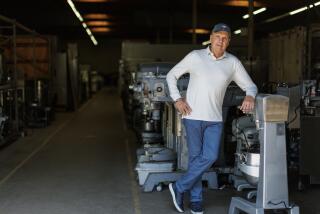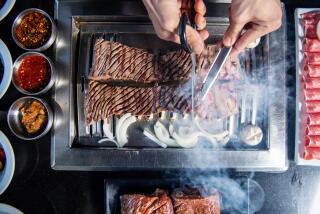Hot Prospects
- Share via
LOS ALAMITOS — Things are cooking at DCS Inc., and the three partners who founded the fast-growing manufacturing firm with a dream and $50,000 in cash less than a decade ago figure they’ll keep on cooking as long as people keep eating hot food.
The company, which makes high-end ovens, ranges, cooktops and gas barbecues for the residential and restaurant markets, has grown from $1.9 million in sales its first full year to $30 million in 1996.
With a planned expansion into the hotel cooking appliance market and a move later this year from Los Alamitos to a new factory and headquarters in Huntington Beach, the company expects its annual sales to increase to $50 million in 1998 and its payroll, now at 525 people, to jump to about 700.
That would make DCS--Dynamic Cooking Systems--one of the largest members of the super-expensive residential stove fraternity, a $200-million-a-year industry dominated by names like Thermador, Garland, Wolf and Viking.
The company’s recipe for success: Turn out products that have more features than the competition’s but cost less. It has achieved that by keeping tight rein on production, materials and distribution costs.
Ranges in the commercial-style residential market run from $2,000 to $7,000. DCS ranges top out at about $5,000. The company also makes a line of commercial-quality outdoor gas barbecues that run from $900 to nearly $4,000.
DCS has broken away from the pack by selling direct to retailers and restaurants, eliminating many of the wholesale middlemen who add a layer of profit to the selling price. Recently, the company also began selling some of its barbecues and patio heaters to Price/ Costco Inc., which undercuts other retailers. That has left some distributors angry, industry insiders say, but it has added to DCS’ blistering growth pace.
The company initially designed and made commercial-style cooktops and ranges for a major appliance company that sold them under its own label. DCS began selling products under its own name a few years ago.
*
Company chairman and co-founder Surjit Kalsi, 63, has been a gas appliance engineer since the late 1950s, when he had to drop out of medical school in London and took a job with a big British appliance maker.
He came to the U.S. in 1980--after a decade of frustration trying to make money with a range manufacturing business in his native India. In 1984, he joined Gardena-based U.S. Range, now Dean/U.S. Range Inc., and was assigned to help develop the nation’s first commercial-style range for home use. He met engineers Roberto Bernal and Randy Rummel, who would become his partners at DCS.
The idea for that first residential restaurant range came from a Mississippi home builder, Fred Carl Jr., who wanted a commercial range for his own home and found he couldn’t install one without making major modifications to the kitchen. Carl started a company called Viking Range Corp. and hired U.S. Range to turn his idea into a real product.
The market for a household range with an oven big enough for two turkeys and a price tag big enough for a decent used car was untested. But Carl had a hunch that the popular television sitcom “Family Ties”--filmed largely in a residential kitchen dominated by a restaurant-style cooker--might give the product a boost.
“Yuppies saw that show and wanted those ranges,” Kalsi says.
They still do. “It’s a big fad,” says Marvin Lurie, gas appliance specialist for the National Assn. of Retail Dealers.
Jerry Beatty, appliance editor for Home Furnishings Network, the industry trade journal, figures that sales of commercial-style products, including ranges and refrigerators, have doubled since 1990 and now make up about 3% of the $19-billion annual market for major household appliances.
*
In 1984, however, nobody could find a restaurant range for the home because the products weren’t sufficiently insulated and didn’t meet safety requirements.
It took Kalsi’s team about a year to engineer a residential version and get it approved by industry safety agencies, and another year for U.S. Range to gear up a production line for Viking, which now designs and makes its own products in Greenwood, Miss. Viking shipped its first residential ranges in 1987.
Kalsi and his partners entered the market in 1988, starting DCS after he was fired from U.S. Range in a conflict with the company’s then general manager.
The incident apparently has created an ongoing feud. The manager, Reinhart Metzger, became president of Thermador Corp. in 1994 and immediately canceled a contract that was providing DCS about half of the income generated from manufacturing commercial-style ranges. Last year, DCS sued Thermador over marketing tactics. The legal dispute has since been settled out of court.
Metzger says there’s nothing in the relationship worth talking about. “That kind of person,” he said of Kalsi, “can’t see that there’s nothing personal about some of these business decisions.”
Now, the two firms are destined to become neighbors. Metzger recently moved Thermador’s headquarters from Vernon to Huntington Beach, near DCS’ new facility.
Kalsi delights in pointing out how much he has prospered since being fired. “I took it as an opportunity to get back into the driver’s seat,” he said.
He and partners Rummel and Bernal are equal owners of the company, but Kalsi--who provided the seed money and is nearly 30 years older--is the company’s marketing force and public voice.
The three spent 1988 developing a commercial quality drop-in cooktop--just burners, not an oven--with all the restaurant-style features that Viking touted for its full-size range.
In January 1989, DCS took its cooktop to the National Assn. of Homebuilders’ annual trade show, where it caught the attention of several big appliance makers that wanted into the market Viking had created.
Thermador Corp. signed the fledgling business to a manufacturing contract and DCS “went overnight from a little three-man business with 20 sales a month to 300 sales a month,” Kalsi said. Revenue hit $1.9 million that first year and DCS never looked back.
The company since has added barbecues, patio heaters and commercial restaurant ranges to its line. In January 1995, a month after its contract with Thermador ended, DCS began marketing high-end, commercial-style residential ranges under its own name.
The ranges featured four burners that can be turned down to simmering levels. While that’s nothing special for the typical household range, commercial units have such large burners that they cannot usually be turned low enough to simmer. Most competitors offer only one specially equipped “simmer burner.”
DCS also provided oversized oven windows to give cooks a better look at what is inside, used stainless steel griddles when the industry standard was cast iron, which rusted, and had custom grill units with channels to drain away fat so it wouldn’t fall onto the cooking element and cause flare-ups. The units were priced as much as $2,000 below the competition.
DCS recently signed a contract to manufacture commercial-style residential ranges for a major European appliance company and is negotiating a similar deal with a U.S. firm. The company also plans to launch a line of ranges and other food preparation products for the hotel business, Kalsi said.
“Everywhere I go on marketing trips,” he says of his frequent overseas flights, “there’s a new luxury hotel going up. It is a huge business.”
To handle all the recent growth and prepare for what they believe will be a new spurt, the DCS partners recently retained Newport Beach builder Master Development Corp. to design and build a state-of-the-art factory and office facility at the McDonnell Douglas business park in Huntington Beach. DCS is renting the 165,000-square-foot building and 12 acres of land under a 10-year lease with an option to purchase the property at some point.
If things go according to plan, DCS will execute its option in five years, Kalsi says.
“Business,” he says, “has been growing ever since we started, and it isn’t stopping.”
(BEGIN TEXT OF INFOBOX / INFOGRAPHIC)
Costly Kitchens
The average cost of adding a professionally designed kitchen was $21,200 in 1995. Built-in appliances such as stoves and cooktops were among the most common elements added.
Favorite Elements:
Microwave oven: 87%
Pull-out shelves: 81%
Garbage disposal: 71%
Built-in appliances: 71%
Custom cabinets: 60%
Pantry cabinets: 57%
Kitchen island: 56%
Source: National Kitchen and Bath Assn.
Advanced Degrees
Gourmet home cooks and professional chefs favor commercial cooking appliances for their dramatic temperature control and reliable calibration. Scaled-down versions of the hulking stainless-steel status symbols are now a multimillion-dollar industry. Some of the major players in the home and commercial kitchen appliance business:
*--*
Company Headquarters 1995 Sales* Employees Hobart Corp. Ohio $400 1,800 Vulcan-Hart Corp. Kentucky 85 750 Thermador Corp. Huntington Beach 75 550 Garland Commercial Pennsylvania 45 350 Industries Inc. Viking Range Co. Mississippi 40 225 Wolf Range Co. Compton 25 300 Dean/U.S. Range Co.** Gardena 22 170 Dynamic Cooking Systems Inc. Los Alamitos 20 535
*--*
* In millions
** Division of Welbilt Inc.
APPLIANCE TYPES
* Range: Free-standing or built-in unit combining oven and open burners. Can include griddle and indoor grill as well
* Cooktop: A unit that fits into an opening in the kitchen counter. Has burners, but no oven
* Wall oven: Fits into wall cabinet, has no cooktop
BY THE NUMBERS
* BTU (British thermal unit): Universal measure of heat energy; quantity of heat needed to raise the temperature of one pound of water by one degree Fahrenheit
* Heat: A low flame will burn your finger just as badly as will as a high flame. Both contain the same amount of heat. It is the amount or volume of flame (or heat in the case of an electric burner) that a pot or pan is exposed to that determines how fast its contents will cook. This output is measured in BTUs.
* Standard residential output: Burners on typical residential ranges and cooktops usually provide adjustable output of 500 to 10,000 BTUs. with a single ring of flame
* Commercial-style residential output: Equipped with single- or sometimes double-ring burners that can provide 15,000 BTUs but usually cannot be turned low enough to simmer (500 BTUs)
* Commercial ranges: Typically provide from 25,000 to a maximum of 40,000 BTUs
* Specialty equipment: DCS makes a gas-fired cooking ring for stir-frying Chinese food that produces 135,000 BTUs, or 13 times the heat output of burners on a standard kitchen range
Sources: Dynamic Cooking Systems, National Assn. of Retail Dealers, Thermador Corp., 1996 Wards Business Directory of U.S. Private and Public Companies; Researched by JOHN O’DELL and JANICE L. JONES / Los Angeles Times
More to Read
Inside the business of entertainment
The Wide Shot brings you news, analysis and insights on everything from streaming wars to production — and what it all means for the future.
You may occasionally receive promotional content from the Los Angeles Times.










